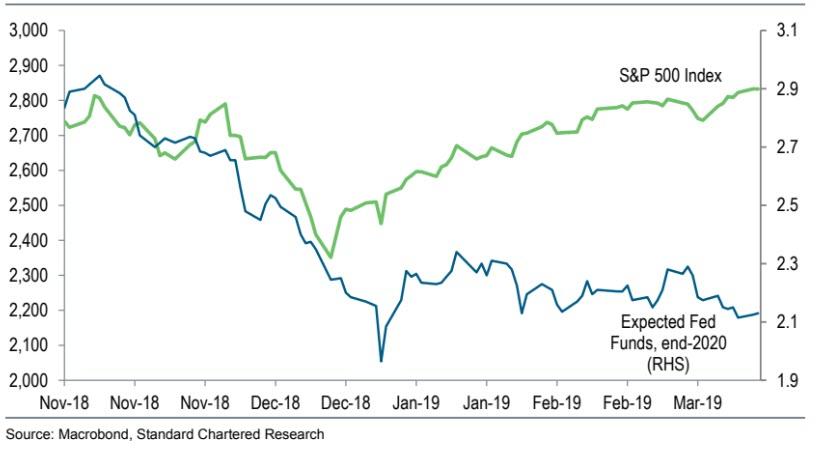
IPFS News Link • Finance - Money Management
Who Is Right - Stocks Or Bonds?
• https://www.zerohedge.comAuthored by Steve Englander via Standard Chartered,
Fed funds futures price the Fed to ease in the next two years; equities are at their highest so far in 2019
The Fed reaction function reconciles the apparent contradiction
With inflation risk low, investors expect the Fed to act to stabilise growth
We think this will support equity-market expectations if there is any sign of activity slowing
Put a little love in the Fed's heart
Several clients and commentators have noted the apparent contradiction in robust equity markets and expectations of Fed easing in money markets. Equity markets appear to be pricing in vigorous activity, while money markets are pricing in a slump (Figure 1). Our view is that equity and money-market pricing reflects a probability-weighted combination of the three most likely scenarios anticipated by investors: (1) stable growth, flat rates, strong equities; (2) softer growth, aggressive Fed easing; and (3) stronger growth, inflation slightly overshoots 2%, Fed reacts slowly. We see no contradiction, as investors anticipate low inflation and a vigorous Fed reaction to signs of slowing growth, and a slow reaction to a small inflation overshoot of 2%.
This supports our expectation of low rates (see 10Y UST yield – Downside on double death-cross?), though we are less convinced on equity pricing. Our reconciliation explains some of the investor ambivalence to the USD – the above scenarios would not generate much foreign buying of USD assets, except for a relatively low-probability one. We list below our key assumptions and outline the scenarios we think underlie asset-market pricing:
No inflation worries. The Phillips curve is flat, so upside inflation surprises are likely to be modest – 5Y5Y breakevens are slightly over 2% and imply medium-term expected core inflation of 1.6% or 1.7%.
The Fed's discussion of alternative monetary policy targets makes investors think it is tolerant of higher inflation, even in this cycle – why discuss bars if you are not interested in having a drink?
Figure 1: S&P and money markets diverge
S&P index (LHS); expected Fed Funds, end-2020, % (RHS)
The three market scenarios
Scenario 1: Growth is stable (near trend), policy rates are flat and equities do well on normal profits growth Our subjective assessment is that investors assign a 50% probability to this scenario. This is a pretty much 'steady as she goes' scenario without too much excitement but no sharp negative surprises either.
Scenario 2: Growth softens somewhat and the Fed comes to the rescue with aggressive easing. The logic is that the Fed would not want to risk allowing the softening trend to become entrenched and risk reducing already-low inflation and inflation expectations. So, the Fed moves fast on any sign of a slump. The consequence is lower rates, but an equity market that knows the Fed is supportive (we think investors assign this a roughly 35% probability).
Scenario 3: Growth is more robust, the profits trajectory somewhat higher, and inflation overshoots slightly over 2% but remains within an acceptable range, given previous undershooting. The Fed might hike mildly in response, but would not feel the need for an aggressive new round of hikes, given the shortfall over the last decade (20% subjective probability).
We think the remaining risk is divided between a boom scenario, which would drive significant Fed tightening, and a bust that would lead to significant easing. Given how low implied volatility is across asset markets, investors do not appear to be assigning much probability to these more dramatic outcomes.
Consider the three above scenarios where we think probability is concentrated. The highest-probability scenarios imply flat policy rates or significant easing, and the lowest-probability scenario implies modest hikes. We think they net out to the modest easing now priced into money markets.
From the equities perspective, 70% of the probability is concentrated in the first and third scenarios in which trend growth or better should support equity prices. The second scenario has an incipient growth slump but also aggressive Fed easing, which should support both growth and asset prices (with asset prices responding sooner). Whenever equities are under pressure, there is a policy response that pushes back.





















